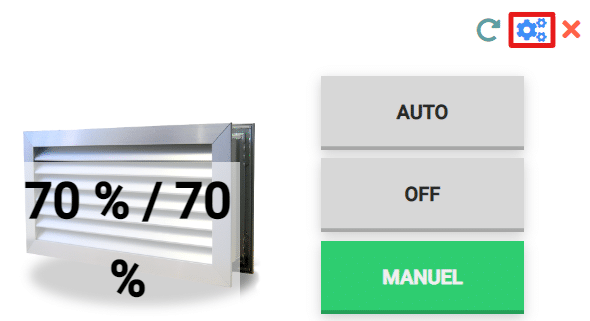1.One pager

2.Configuration
emActuators require thorough initial configuration so that the Agrimesh software can use the air inlets properly. Although this configuration is usually done by one of our technician, the following steps describe in detail how to properly install an emActuator. Feel free to have one of our technicians go over your setup if you want confirmation that everything is setup right.
Preparation
- Log in the Agrimesh Console.
- In the All devices page, find the emActuator to be configured by finding the corresponding serial number. If it is the first time the device is powered, it will appear under the empty-location section.
- Before configuring the emActuator, make sure that the limit switches are installed on the actuator. An emActuator should not be configured if there are no limit switch to prevent the actuator from over extending.
- Click on the emActuator. Let’s place it to the corresponding location. Before saving changes, make sure that the minimum value is set to 0 and the maximum value is set to 4095 (see image below).


- After saving the changes made, refresh the page (press f5 or ctrl+r). Confirm the emActuator is configured in the correct location. If it is not the case, please go over step 4 again.
- Before moving on, please confirm that the wiring of the emActuator is correct.
Setup
- Pressing the test button 1, move the actuator until the trap doors are completely opened or closed. Once the actuator has stopped moving, wait about 2 minutes and find the “value” in the device’s advanced parameters. Take note of the associated number.
- Holding the test button 2 and then the test button 1, move the actuator until the trap doors are completely opened or closed. Once the actuator has stopped moving, wait about 2 minutes and find the “value” in the device’s advanced parameters. Take note of the associated number.
- Those two numbers represent the state of the potentiometer in the emActuator when the air inlets are fully opened and closed. In the device’s configuration, enter the lower value in the Minimum Value field and the higher value in the Maximum Value field. Save changes.

- Now put the emActuator in manual mode and send it to 0%. Once the trap doors stop moving, confirm they are closed. If they are opened, open the configuration for the emActuator once again and check the “Reversed” checkbox.
3.Verify the wiring
After installing an emActuator, it is a good idea to verify the wiring before going through the configuration. In fact, it will not be possible to configure an emActuator that is not wired properly.
- Press the test button 1 (first relay) of the emActuator. The actuator should move one way. If so, you can release the button.
- Press and hold the test button 2 (second relay), then press the test button 1 (first relay). The actuator should move the other way. If so, you can release test button 1, then test button 2.
- Using one of the previous steps, position the actuator so that it is not at the end of its course. Before moving on to the next step, the actuator should be able to move in either direction.
- Head to the Agrimesh Console. Make sure the advanced parameters are displayed.
- Go to the All devices page and find the actuator being tested.
- Amongst the data displayed for the emActuator, find the two following lines: Value and Expected value (use ctrl+f). Those two values should be less than 12 units appart. If you moved the actuator recently, please allow about 2 minutes so that the values update.

- For the final test, activate the first relay of the emActuator using the test button. The actuator will move one way. The expected value will change. The value should change in the same manner as the expected value. If the expected value goes up, the value should go up. If the expected value goes down, the value should go down shortly after. If so, the wiring is good. Great!
While the actuator is moving, the gap between the values should increase until the actuator stops again. Once it stops, the value and the expected value should become the same again, more or less 12 units. If the value doesn’t seem to chase after the expected value, it is most likely because of a faulty wiring.
The emActuator uses a potentiometer to figure out how the shaft is extended. This measure is taken as a 0-5v analogue signal and transposed into a 0-4095 digital output. This output is what is shown in the value field. The expected value is just a target based on our calculations of what the value should be with proper wiring.

